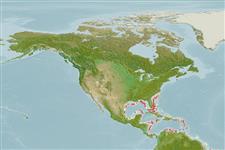>
Acropomatiformes (Oceanic basses) >
Epigonidae (Deepwater cardinalfishes)
Etymology: Epigonus: Greek, epi = over, in front + Greek, gonio = angle (Ref. 45335).
Environment: milieu / climate zone / profondeur / distribution range
Écologie
marin bathydémersal; profondeur 380 - 660 m (Ref. 31632). Deep-water
Western Central Atlantic: Gulf of Mexico and the Caribbean Sea.
Taille / Poids / Âge
Maturité: Lm ? range ? - ? cm
Max length : 18.2 cm SL mâle / non sexé; (Ref. 132290)
Épines dorsales (Total) : 7; Rayons mous dorsaux (Total) : 10. Large scales. Lacks an opercular spine. No enlarged teeth on the lower jaw symphysis (Ref. 31632).
Body shape (shape guide): fusiform / normal.
A mesobenthic-pelagic species living mainly above the bottom (Ref. 31632).
Life cycle and mating behavior
Maturité | Reproduction | Frai | Œufs | Fécondité | Larves
Abramov, A.A., 1992. Species composition and distribution of Epigonus (Epigonidae) in the world ocean. J. Ichthyol. 32(5):94-108. (Ref. 31632)
Statut dans la liste rouge de l'IUCN (Ref. 130435: Version 2025-1)
Menace pour l'homme
Harmless
Utilisations par l'homme
Pêcheries: d'intérêt potentiel
Outils
Articles particuliers
Télécharger en XML
Sources Internet
Estimates based on models
Preferred temperature (Réf.
123201): 8.3 - 11.9, mean 9.6 °C (based on 34 cells).
Phylogenetic diversity index (Réf.
82804): PD
50 = 0.5000 [Uniqueness, from 0.5 = low to 2.0 = high].
Bayesian length-weight: a=0.00646 (0.00275 - 0.01515), b=3.10 (2.89 - 3.31), in cm total length, based on LWR estimates for this (Sub)family-body shape (Ref.
93245).
Niveau trophique (Réf.
69278): 3.5 ±0.5 se; based on size and trophs of closest relatives
Résilience (Réf.
120179): Milieu, temps minimum de doublement de population : 1,4 à 4,4 années (Preliminary K or Fecundity.).
Fishing Vulnerability (Ref.
59153): Low vulnerability (12 of 100).
🛈
